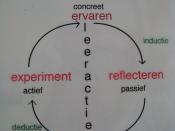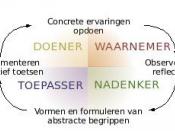1. experiential learning:
a. Experiential education is a philosophy and methodology in which educators purposefully engage with learners in direct experience and focused reflection in order to increase knowledge, develop skills and clarify values. I feel that the most important principals of experiential education are that the learner is actively engaged in the lesson by posing questions, experimenting, solving problems, being responsible, and being creative. The learner should be engaged both physically as well as mentally. The relationship between learner to self, learner to others, and learner to world are also extremely important. Lastly, the learner should learn from natural consequences, mistakes, and successes.
b. The four main segments of the experiential learning cycle are experiencing, reflecting, generalizing, and applying. First, experiencing, a person goes through this stage at every moment of their life. Constantly discovering new things about the world around them. This is a specific activity though. The learner "experiences" the activity or in other words, participates in the activity.
From this, the learner gathers data. The next step in the learning cycle is reflecting. This step takes the data from the experience and incorporates it with past experiences. This allows them to gather in everything they have participated in and make sense of all of it. The third step in the experiential learning cycle is generalizing. This step looks for patterns, emotionally, behaviorally, thoughtfully, and observationally to see if they occur repeatedly. When the patterns are fully understood, they can be applied to other situations. The generalizations made are "what tends to happen" (luckner 6) and not cold hard facts. The final step in the learning cycle is the application. This step takes all the data gathered and generalizations made from the learner and he/she uses them in other similar situations.
c. There are at least two...


